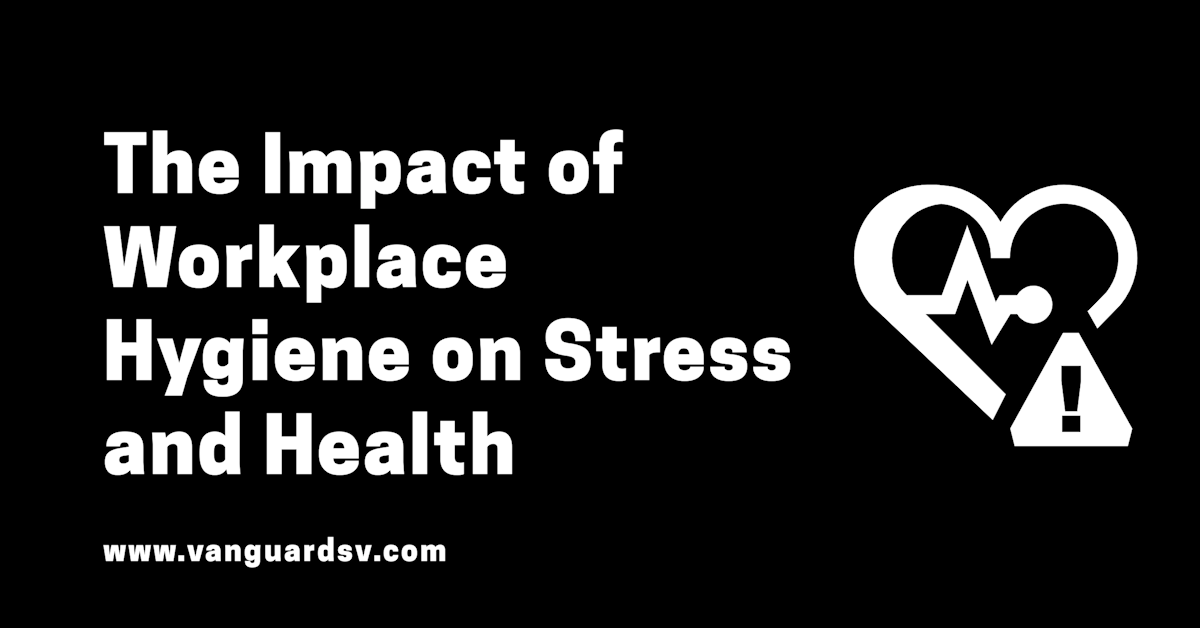A clean and hygienic workplace can help reduce stress levels, improve health, and boost employee productivity.

The Impact of Workplace Environments on Occupant Stress and Health
Occupational stress theories have long posited a relationship between workplace hygiene and worker stress.
In particular, the presence of pathogens and other contaminants in the workplace can increase the risk of illness, leading to lost productivity and increased stress levels.
The sick building syndrome (SBS) is used to describe a situation in which the occupants of a building experience acute health- or comfort-related effects that seem to be linked directly to the time spent in the building.
[Signs and symptoms include] [h]eadache, dizziness, nausea, eye, nose or throat irritation, dry cough, dry or itching skin, difficulty in concentration, fatigue, sensitivity to odours, hoarseness of voice, allergies, cold, flu-like symptoms, increased incidence of asthma attacks and personality changes.
The cause of the symptoms is not known. It reduces work efficiency and increases absenteeism. [1]
Additionally, an unhygienic workplace can be unpleasant and uncomfortable, which can contribute further to feelings of stress and anxiety. [2]
Conversely, a clean and hygienic workplace can help to reduce stress levels, improve health, and boost productivity. [3]
The Impact of Stress on the Immune System
The immune system is the body's natural defense mechanism against foreign invaders.
It includes a variety of cells, proteins, and organs that work together to protect the body from infection.
Stress can negatively impact the immune system, making people more susceptible to infections, diseases, and other health problems by activating the hypothalamic-pituitary-adrenal (HPA) axis, which is a system of glands that release hormones that can suppress immune function.
How people perceive stress, their mood, and the number of adverse life events they experience can all influence how much stress impacts their immune system.
Chronic stress can lead to inflammation, increasing the risk of severe health problems such as cardiovascular disease, diabetes, and cancer. [4]
Improving Workplace Stress Metrics With Enhanced Cleaning
Enhanced cleaning measures can improve workplace stress metrics in several ways.
- Reduced exposure to allergens and pollutants - A clean workplace is less likely to have allergens and pollutants that can trigger allergic reactions or asthma attacks. This can help reduce stress levels and improve overall health.
- Improved air quality - A clean workplace has cleaner air, which can help improve respiratory health and reduce stress levels.
- Reduced clutter and distractions - A clean and organized workplace is less cluttered and distracting, which can help employees focus and be more productive. This can lead to reduced stress levels.
- Improved morale - A clean and well-maintained workplace can boost morale and make employees feel more valued. This can lead to reduced stress levels and improved job satisfaction.
In addition to these direct effects, enhanced cleaning measures can also have some indirect benefits that can help reduce stress.
For example, a clean and well-organized workplace can make it easier for employees to find what they need, which can save time and reduce stress.
Additionally, a clean and well-maintained workplace can create a more positive and welcoming environment, which can help reduce stress levels.
Tips for Improving Workplace Hygiene
- Provide regular cleaning and sanitation services. This includes cleaning surfaces, floors, and equipment, as well as disposing of waste properly.
- Encourage workers to practice good personal hygiene. This includes washing hands frequently, covering coughs and sneezes, and disposing of tissues properly.
- Maintain a clean and organized workplace. This can help reduce clutter and make it easier to keep surfaces clean.
- Train employees on proper hygiene practices. This can help ensure that everyone understands the importance of workplace hygiene and knows how to practice it effectively.
References
- Joshi, S. (2008). The sick building syndrome. Indian Journal of Occupational and Environmental Medicine, 12(2), 61. https://doi.org/10.4103/0019-5278.43262
- Al horr, Y., Arif, M., Katafygiotou, M., Mazroei, A., Kaushik, A., & Elsarrag, E. (2016). Impact of indoor environmental quality on occupant well-being and comfort: A review of the literature. International Journal of Sustainable Built Environment, 5(1), 1–11. https://doi.org/10.1016/j.ijsbe.2016.03.006
- Contributor, G. (2017, December 4). Why Workplace Cleanliness Is Key. Facility Executive Magazine. https://facilityexecutive.com/workplace-cleanliness-key/
- Seiler, A., Fagundes, C. P., & Christian, L. M. (2019). The Impact of Everyday Stressors on the Immune System and Health. Stress Challenges and Immunity in Space, 71–92. https://doi.org/10.1007/978-3-030-16996-1_6
Takeaway
By providing a clean and hygienic workplace, employers can help reduce stress levels, improve health, and boost productivity among their employees.
Outsourcing is a proven method for onboarding highly in-demand cleaning and sanitization services and experience for a fraction of the price of maintaining a similar service in-house.
If you would like more information regarding the effectiveness of high-performance infection prevention and control measures, or if you would like to schedule a free, no-obligation on-site assessment of your facility's custodial needs, contact us today for a free quote!
In Bakersfield, CA, call (661) 437-3253
In Fresno, CA, call (559) 206-1059
In Valencia, CA, or Santa Clarita, CA, call (661) 437-3253
In Palmdale, CA, or Lancaster, CA, call (661) 371-4756

